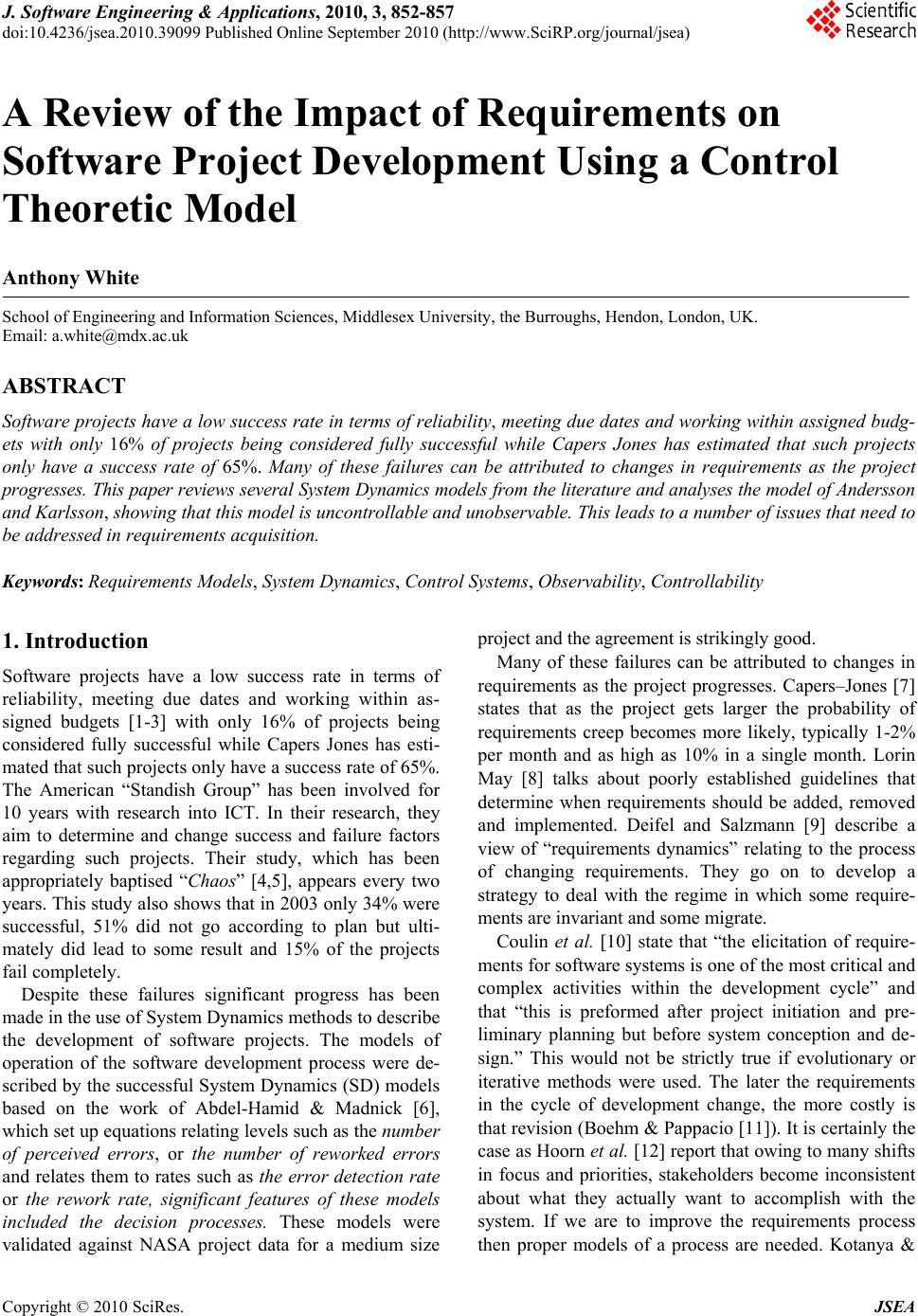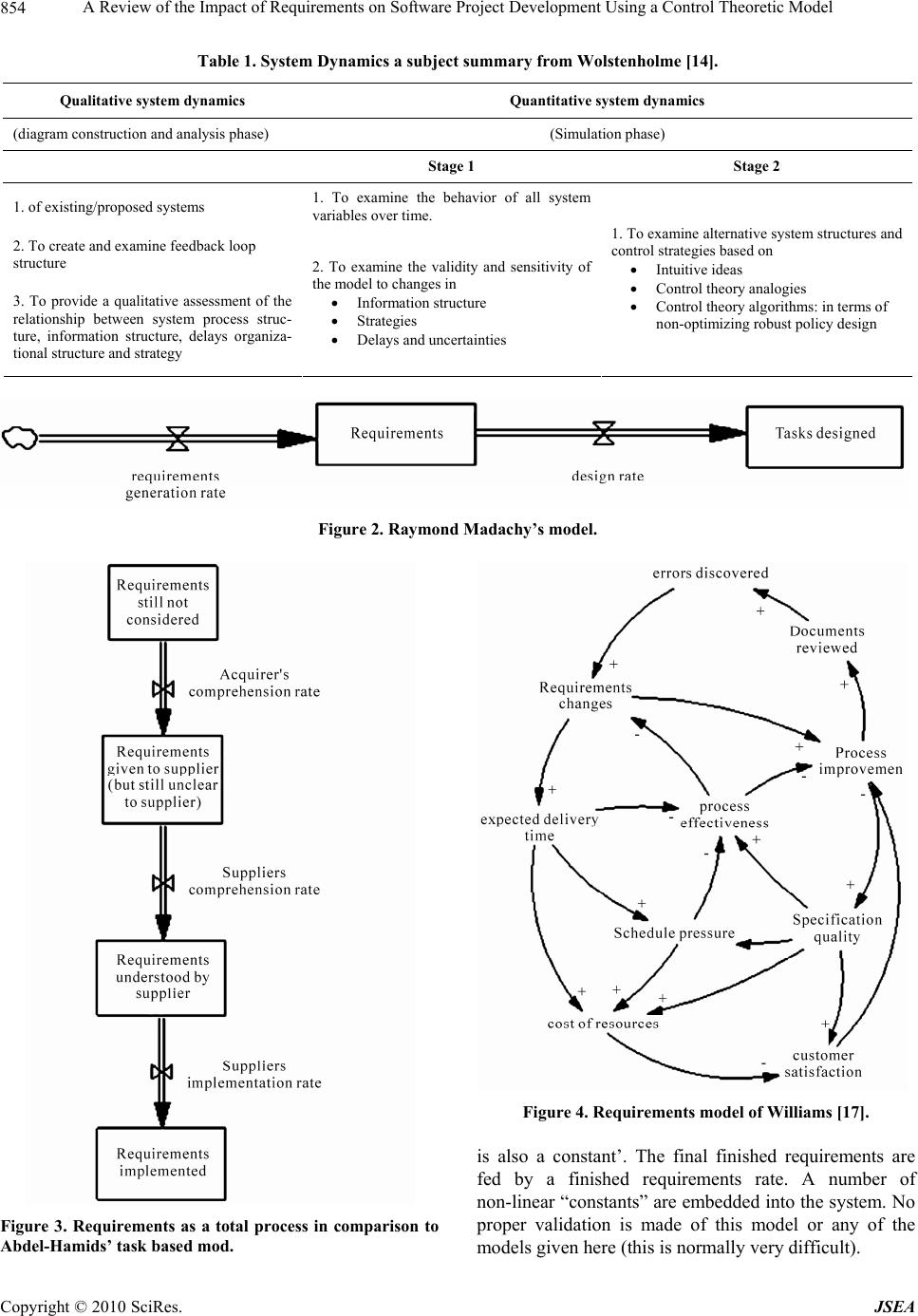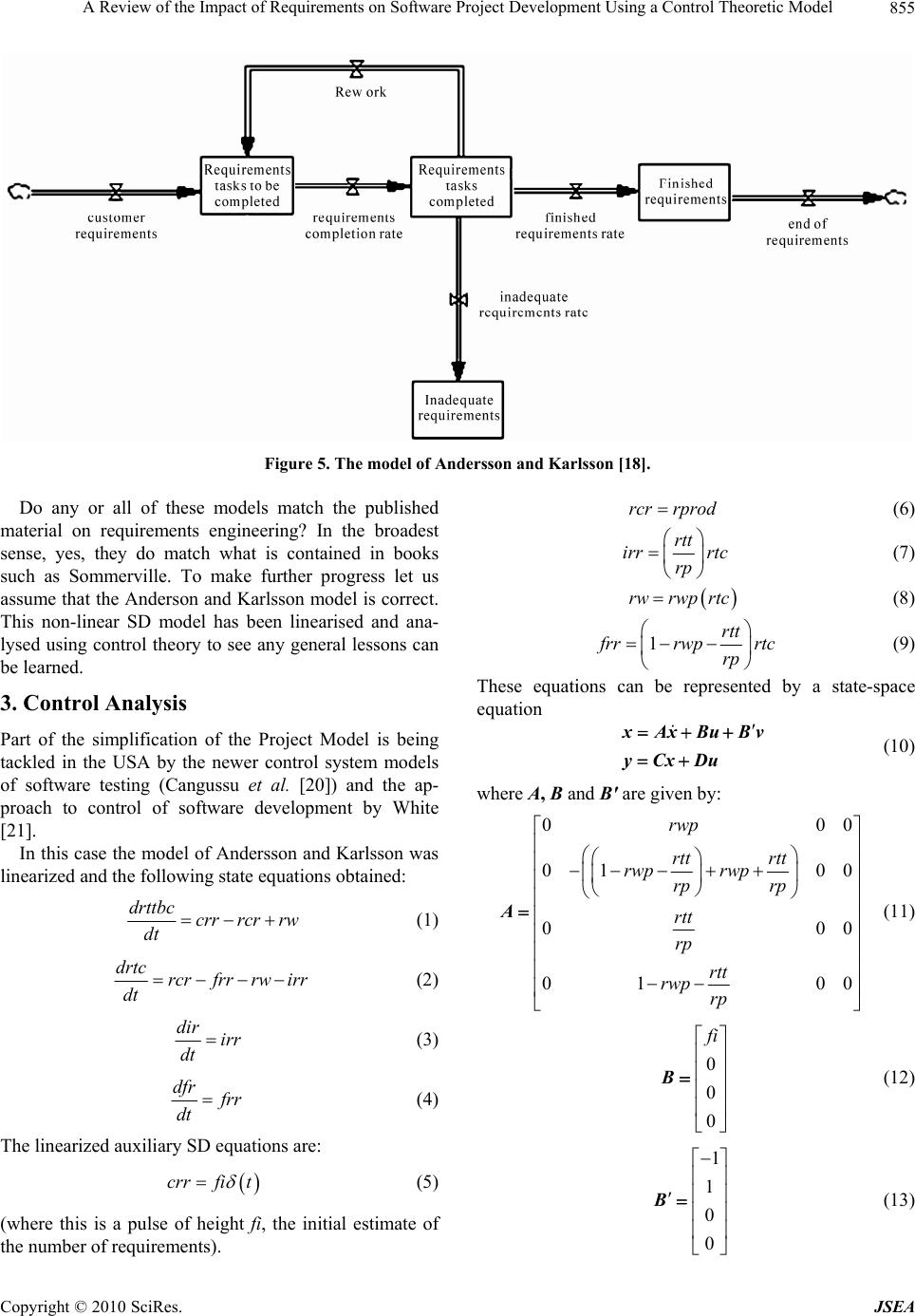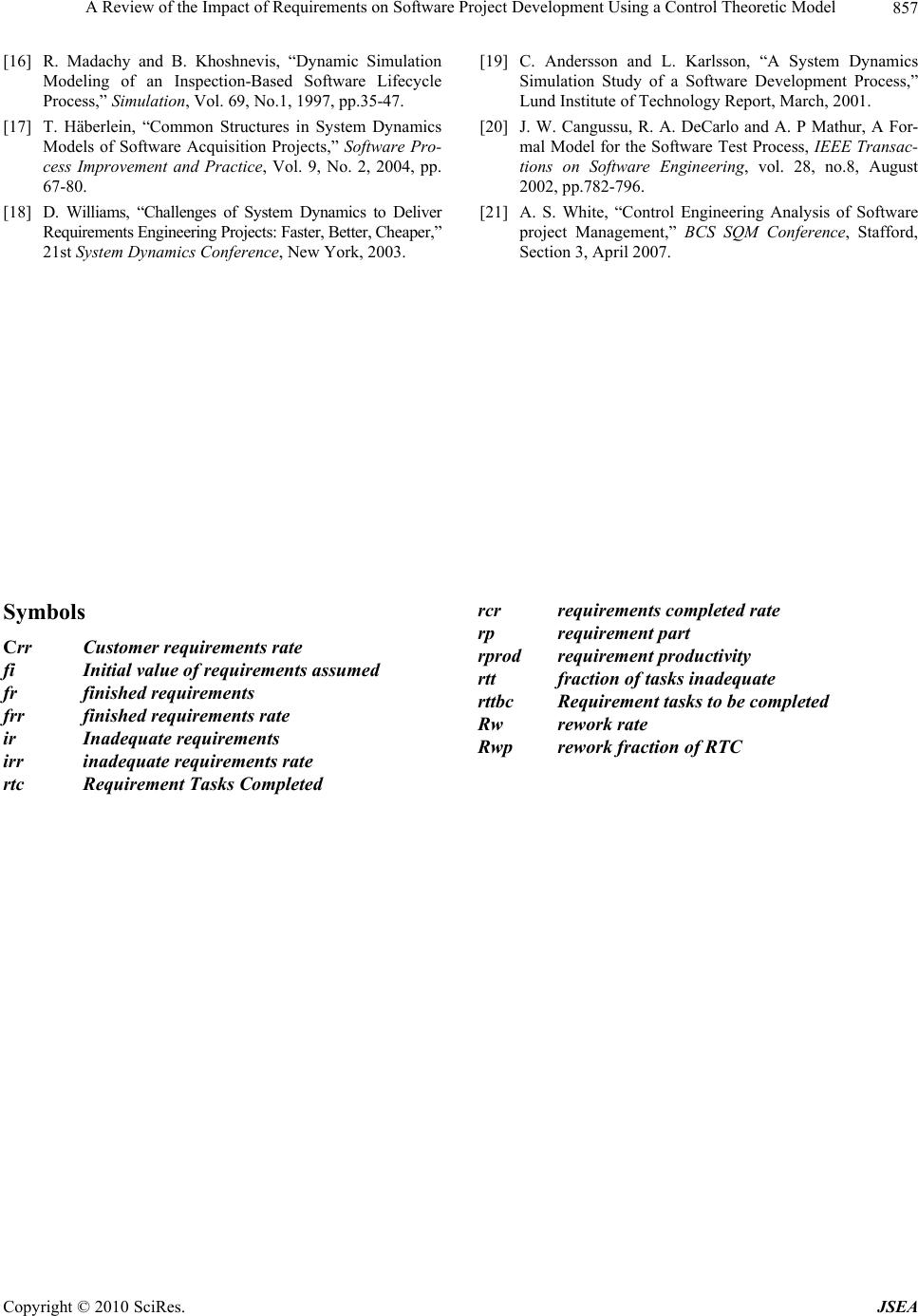Paper Menu >>
Journal Menu >>
 J. Software Engineering & Applications, 2010, 3, 852-857 doi:10.4236/jsea.2010.39099 Published Online September 2010 (http://www.SciRP.org/journal/jsea) Copyright © 2010 SciRes. JSEA A Review of the Impact of Requirements on Software Project Development Using a Control Theoretic Model Anthony White School of Engineering and Information Sciences, Middlesex University, the Burroughs, Hendon, London, UK. Email: a.white@mdx.ac.uk ABSTRACT Software projects have a low success rate in terms of reliability, meeting due dates and working within assigned budg- ets with only 16% of projects being considered fully successful while Capers Jones has estimated that such projects only have a success rate of 65%. Many of these failures can be attributed to changes in requirements as the project progresses. This paper reviews several System Dynamics models from the literature and analyses the model of Andersson and Karlsson, showing that this model is uncontrollable and unobservable. This leads to a number of issues that need to be addressed in requirements acquisition. Keywords: Requirements Models, System Dynamics, Control Systems, Observability, Controllability 1. Introduction Software projects have a low success rate in terms of reliability, meeting due dates and working within as- signed budgets [1-3] with only 16% of projects being considered fully successful while Capers Jones has esti- mated that such projects only have a success rate of 65%. The American “Standish Group” has been involved for 10 years with research into ICT. In their research, they aim to determine and change success and failure factors regarding such projects. Their study, which has been appropriately baptised “Chaos” [4,5], appears every two years. This study also shows that in 2003 only 34% were successful, 51% did not go according to plan but ulti- mately did lead to some result and 15% of the projects fail completely. Despite these failures significant progress has been made in the use of System Dynamics methods to describe the development of software projects. The models of operation of the software development process were de- scribed by the successful System Dynamics (SD) models based on the work of Abdel-Hamid & Madnick [6], which set up equations relating levels such as the number of perceived errors, or the number of reworked errors and relates them to rates such as the error detection rate or the rework rate, significant features of these models included the decision processes. These models were validated against NASA project data for a medium size project and the agreement is strikingly good. Many of these failures can be attributed to changes in requirements as the project progresses. Capers–Jones [7] states that as the project gets larger the probability of requirements creep becomes more likely, typically 1-2% per month and as high as 10% in a single month. Lorin May [8] talks about poorly established guidelines that determine when requirements should be added, removed and implemented. Deifel and Salzmann [9] describe a view of “requirements dynamics” relating to the process of changing requirements. They go on to develop a strategy to deal with the regime in which some require- ments are invariant and some migrate. Coulin et al. [10] state that “the elicitation of require- ments for software systems is one of the most critical and complex activities within the development cycle” and that “this is preformed after project initiation and pre- liminary planning but before system conception and de- sign.” This would not be strictly true if evolutionary or iterative methods were used. The later the requirements in the cycle of development change, the more costly is that revision (Boehm & Pappacio [11]). It is certainly the case as Hoorn et al. [12] report that owing to many shifts in focus and priorities, stakeholders become inconsistent about what they actually want to accomplish with the system. If we are to improve the requirements process then proper models of a process are needed. Kotanya &  A Review of the Impact of Requirements on Software Project Development Using a Control Theoretic Model Copyright © 2010 SciRes. JSEA 853 Sommerville [13] outlines the requirements engineering process as shown in Figure 1. Although there is feed- back between requirements validation and specification and in the elicitation and specification as will be shown this is not represented in the current models. It is not clear in any of the texts on the subject whether the in- volvement of the use is mandated at these stages. The whole purpose of this paper is to present simple control system models of the project development process including requirements, as in inventory analysis, and demonstrate rules for stability. 2. System Dynamics Wolstenholme [14] describes System Dynamics as: “A rigorous method for qualitative description, explo- ration and analysis of complex systems in terms of their processes, information, organizational structure and strategies; which facilitates simulation modelling and quantitive analysis for the design of system structure and control”. This definition is expanded in Table 1 taken from Wolstenholme. The SD model structure is highly non-linear with a number of theoretical assumptions, for example about how the errors in the coding are propagated. These structural assumptions do not allow for System Dynamics models to enable any general rules to be de- veloped by academics for managers to make sound judgments based on good analysis. The distinction with models of inventory processes, which are related, is the rationale for this research program. Early SD invent- tory models developed by Forrester [15] were also non-linear and contained a number of factors, such as employment rate, that made the problem too complex for simple rules to be developed. The simplest expression of representation of require- ments in SD models is that use by Madachy [16], shown in Figure 2. In this case requirements are added to by a rate of generation, usually constant. The time taken to acquire the whole requirements is dictated by the acqui- sition rate. Häberlein [17] proposed a different structure for the development of the whole project. In his model (Figure 3) the rate of generation of requirements is split into several phases depending on the comprehension of the supplier and how this is influenced. This model could show considerable promise but no equations are pre- sented. The model of Williams [18] (Figure 4) could not be evaluated further at this time due to incomplete equa- tions. The structure indicated shows dependence on quantities such as customer satisfaction that are not read- ily measured during the process. The model of Anders- son and Karlsson [19] (Figure 5) is the most complete and useful model out in the literature. Not only are all the equations given, with data, but the results are of a project in industry. This model shows that the process of gaining requirements is split into a phase where the level of re- quirements tasks to be completed is gained via an input pulse function. The required tasks to be completed are fed from the previous state by a constant requirements completion rate. Rework is discovered in these require- ments and this is fed back at a constant rate to the first level. Inadequate requirements are discarded at a rate that Figure 1. Requirements engineering (from Kotanya & Sommerville).  A Review of the Impact of Requirements on Software Project Development Using a Control Theoretic Model Copyright © 2010 SciRes. JSEA 854 Table 1. System Dynamics a subject summary from Wolstenholme [14]. Qualitative system dynamics Quantitative system dynamics (diagram construction and analysis phase) (Simulation phase) Stage 1 Stage 2 1. of existing/proposed systems 1. To examine the behavior of all system variables over time. 2. To create and examine feedback loop structure 3. To provide a qualitative assessment of the relationship between system process struc- ture, information structure, delays organiza- tional structure and strategy 2. To examine the validity and sensitivity of the model to changes in Information structure Strategies Delays and uncertainties 1. To examine alternative system structures and control strategies based on Intuitive ideas Control theory analogies Control theory algorithms: in terms of non-optimizing robust policy design Figure 2. Raymond Madachy’s model. Figure 3. Requirements as a total process in comparison to Abdel-Hamids’ task based mod. Figure 4. Requirements model of Williams [17]. is also a constant’. The final finished requirements are fed by a finished requirements rate. A number of non-linear “constants” are embedded into the system. No proper validation is made of this model or any of the models given here (this is normally very difficult).  A Review of the Impact of Requirements on Software Project Development Using a Control Theoretic Model Copyright © 2010 SciRes. JSEA 855 Figure 5. The model of Andersson and Karlsson [18]. Do any or all of these models match the published material on requirements engineering? In the broadest sense, yes, they do match what is contained in books such as Sommerville. To make further progress let us assume that the Anderson and Karlsson model is correct. This non-linear SD model has been linearised and ana- lysed using control theory to see any general lessons can be learned. 3. Control Analysis Part of the simplification of the Project Model is being tackled in the USA by the newer control system models of software testing (Cangussu et al. [20]) and the ap- proach to control of software development by White [21]. In this case the model of Andersson and Karlsson was linearized and the following state equations obtained: drttbc crr rcr rw dt (1) drtc rcrfrrrw irr dt (2) dir irr dt (3) dfr f rr dt (4) The linearized auxiliary SD equations are: crrfi t (5) (where this is a pulse of height fi, the initial estimate of the number of requirements). rcrrprod (6) rtt irr rtc rp (7) rwrwp rtc (8) 1rtt f rrrwp rtc rp (9) These equations can be represented by a state-space equation xAxBuBv yCxDu (10) where A, B and B' are given by: 000 01 00 000 01 00 rwp rtt rtt rwp rwp rp rp rtt rp rtt rwp rp A (11) 0 0 0 f i B (12) 1 1 0 0 B (13)  A Review of the Impact of Requirements on Software Project Development Using a Control Theoretic Model Copyright © 2010 SciRes. JSEA 856 0001C (14) D (15) rttbc rtc ir f r x (16) where u = pulse function and v = rprod. In this configu- ration v acts as a disturbance. State-space theory can be used to see if this system is either controllable or observable. We can define two matrices that will allow a measure of these properties if they are both full rank. The control stability is defined by the four eigenvalues two zero and two damped complex conjugates. The system is neutrally stable at best. 23 Cm=B AB AB AB (17) The rank of Cm is 1! The observability is given by: 2 3 C CA Om =CA CA (18) The rank of this matrix is also 1. This means that the system described by the linearized state equations is un- controllable and unobservable! The principle reason for this is that no corrective forces exist to alter the rate of production of requirements and that the rework and in- adequate requirements cannot be altered independently of each other. Although a set of parameters will allow the requirements to be produced, once set in train no process exists to vary that process. No variation in workforce for example is set up in this model. No simple solutions allow this model to be put into a controllable form, al- though it can be made observable. 4. Conclusions All the SD models illustrated here would appear to use a constant rate of conversion of requirement wishes from the customer to specifications, depending strictly on staff productivity. The number of staff in the cases cited appears to be fixed at the start of the process and altered only reluctantly, taking no account of project size or complexity. If this is generally true it has severe implica- tions for the later analysis and development of the project. The most comprehensive model cited, due to Andersson and Karlsson has been analysed from a control system viewpoint. This analysis shows that such models are neutrally stable since there are no feedback mechanisms to establish when all the requirements are obtained, and they are neither controllable nor observable. The problem is that only the group of states fr, ir and rtc together are specified, one of them cannot be separately described or made to achieve a particular trajectory If the staff pro- ductivity is fixed and the number of staff is decided be- forehand then the final outcome is proscribed. They can with some manipulation be made stabilizable. REFERENCES [1] J. Smith, “The 40 Root Causes of Troubled IT Projects,” Computing and Control Journals, June 2002, pp.109-112. [2] K. T. Yeo, “Critical Failure Factors in Information Sys- tem Projects,” International Journals of Project Man- agement, Vol. 20, 2002, pp. 241-246. [3] Royal Academy of Engineering, “The Challenges of Complex IT projects,” Report of working group of RAE and BCS, 2004. [4] The Standish Group International Inc., Standard Group CHAOS Report. 1998 [5] The Standish Group International Inc., Standard Group CHAOS Report, 25 March 2003 [6] T. Abdel-Hamid and S. E. Madnick, “Software Project Dynamics: An Integrated Approach,” Englewood Cliffs, Prentice Hall, New York, 1991. [7] C. Jones, “Large Software System Failures and Suc- cesses,” American Programmer, April 1996, pp.3-9. [8] L. J. May, “Major Causes of Software Project Failures,” Crosstalk, July 1998. [9] B. Deifel and C. Salzmann, “Requirements and Condi- tions for Dynamics in Evolutionary Software Systems,” Proceedings of the International Workshop on the Prin- ciples of Software Evolution, IWPSE99, Fukuoka, 1999. [10] C. Coulin, D. Zowghi and A. Sahraoui, “A Situational Method Engineering Approach to Requirements Elicita- tion Workshops in the Software Development Process,” Software Process Improvement and Practice, Vol. 11, No. 5, 2006, pp.451-465. [11] B. Boehm and P. N. Pappacio, “Understanding and Con- trolling Software Costs,” IEEE Transactions on software engineering, Vol. 14, 1988, pp.1462-1477. [12] J. F. Hoorn, M. E. Breuker and E. Kok, “Shifts in Foci and Priorities. Different Relevance of Requirements to Changing Goals Yields Conflicting Prioritizations and Its Viewpoint,” Software Process Improvement and Practice, Vol. 11, No. 5, 2006, pp. 465-485. [13] G. Kotonya and I. Sommerville, “Requirements Engi- neering Processes and Techniques,” Wiley, 1988. [14] E. Wolstenholme, “A Current Overview of System Dy- namics,” Transactions on Institute MC, Vol. 114, No. 4, 1989, pp. 171-179. [15] J. Forrester, “Industrial Dynamics,” MIT press, Boston, 1961.  A Review of the Impact of Requirements on Software Project Development Using a Control Theoretic Model Copyright © 2010 SciRes. JSEA 857 [16] R. Madachy and B. Khoshnevis, “Dynamic Simulation Modeling of an Inspection-Based Software Lifecycle Process,” Simulation, Vol. 69, No.1, 1997, pp.35-47. [17] T. Häberlein, “Common Structures in System Dynamics Models of Software Acquisition Projects,” Software Pro- cess Improvement and Practice, Vol. 9, No. 2, 2004, pp. 67-80. [18] D. Williams, “Challenges of System Dynamics to Deliver Requirements Engineering Projects: Faster, Better, Cheaper,” 21st System Dynamics Conference, New York, 2003. [19] C. Andersson and L. Karlsson, “A System Dynamics Simulation Study of a Software Development Process,” Lund Institute of Technology Report, March, 2001. [20] J. W. Cangussu, R. A. DeCarlo and A. P Mathur, A For- mal Model for the Software Test Process, IEEE Transac- tions on Software Engineering, vol. 28, no.8, August 2002, pp.782-796. [21] A. S. White, “Control Engineering Analysis of Software project Management,” BCS SQM Conference, Stafford, Section 3, April 2007. Symbols Crr Customer requirements rate fi Initial value of requirements assumed fr finished requirements frr finished requirements rate ir Inadequate requirements irr inadequate requirements rate rtc Requirement Tasks Completed rcr requirements completed rate rp requirement part rprod requirement productivity rtt fraction of tasks inadequate rttbc Requirement tasks to be completed Rw rework rate Rwp rework fraction of RTC |

